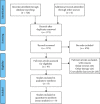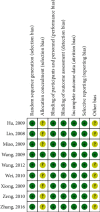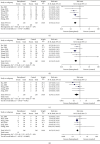Efficacy and Safety of Butorphanol Use in Patient-Controlled Analgesia: A Meta-Analysis
- PMID: 34335812
- PMCID: PMC8324365
- DOI: 10.1155/2021/5530441
Efficacy and Safety of Butorphanol Use in Patient-Controlled Analgesia: A Meta-Analysis
Erratum in
-
Corrigendum to "Efficacy and Safety of Butorphanol Use in Patient-Controlled Analgesia: A Meta-Analysis".Evid Based Complement Alternat Med. 2021 Oct 23;2021:9854850. doi: 10.1155/2021/9854850. eCollection 2021. Evid Based Complement Alternat Med. 2021. PMID: 34725558 Free PMC article.
Abstract
Objective: This meta-analysis evaluates the efficacy and safety regarding usage of butorphanol in patient-controlled analgesia (PCA).
Methods: Several databases such as PubMed, Cochrane Library, Embase, CNKI, and VIP were explored with the help of computer search and manual retrieval. Randomized controlled trial (RCT) was selected, and the meta-analysis was conducted using RevMan 5.1. The primary efficacy endpoint was the postoperative visual analog scale score, postoperative Ramsay sedation scale (RSS), and adverse events.
Results: Nine RCTs met the inclusion criteria and were included in this meta-analysis. No significant differences were found between the butorphanol group and nonbutorphanol group at 12 h and 48 h. The postoperative RSS score at 12 h, 24 h, and 48 h was representative of the calming effect of butorphanol. No significant difference was found on the endpoint of the postoperative RSS score at 12 h, 48 h, and 24 h. The RSS score was lower in the butorphanol group in comparison to the nonbutorphanol group. The butorphanol group was also associated with lower rate of nausea, vomiting, itching, and dizziness compared to the nonbutorphanol group.
Conclusion: Butorphanol may be used in PCA as a successful postoperative analgesia and is also associated with lower side effects. Further research is needed to verify the efficacy and safety of butorphanol.
Copyright © 2021 Zhihua Zhu and Wenyu Zhang.
Conflict of interest statement
The authors declare that they have no conflicts of interest.
Figures







Similar articles
-
The Effectiveness and Safety of Intravenous Dexmedetomidine of Different Concentrations Combined with Butorphanol for Post-Caesarean Section Analgesia: A Randomized Controlled Trial.Drug Des Devel Ther. 2021 Feb 18;15:689-698. doi: 10.2147/DDDT.S287512. eCollection 2021. Drug Des Devel Ther. 2021. PMID: 33628014 Free PMC article. Clinical Trial.
-
Intraoperative and postoperative infusion of dexmedetomidine combined with intravenous butorphanol patient-controlled analgesia following total hysterectomy under laparoscopy.Exp Ther Med. 2018 Nov;16(5):4063-4069. doi: 10.3892/etm.2018.6736. Epub 2018 Sep 13. Exp Ther Med. 2018. PMID: 30402150 Free PMC article.
-
Efficacy of Thoracolumbar Interfascial Plane Block for Postoperative Analgesia in Lumbar Spine Surgery: A Meta-analysis of Randomized Clinical Trials.Pain Physician. 2021 Nov;24(7):E1085-E1097. Pain Physician. 2021. PMID: 34704718
-
Efficacy and safety of dexmedetomidine combined with tramadol for patient-controlled intravenous analgesia in Chinese surgical patients: A systematic review and meta-analysis.Medicine (Baltimore). 2020 Jan;99(3):e18825. doi: 10.1097/MD.0000000000018825. Medicine (Baltimore). 2020. PMID: 32011494 Free PMC article.
-
Effect of butorphanol on etomidate-induced myoclonus: a systematic review and meta-analysis.Drug Des Devel Ther. 2019 Apr 16;13:1213-1220. doi: 10.2147/DDDT.S191982. eCollection 2019. Drug Des Devel Ther. 2019. PMID: 31114161 Free PMC article.
Cited by
-
Impact of butorphanol versus sufentanil on postoperative cognition and inflammation in elderly: a pilot study.Front Aging Neurosci. 2024 Jun 7;16:1395725. doi: 10.3389/fnagi.2024.1395725. eCollection 2024. Front Aging Neurosci. 2024. PMID: 38912522 Free PMC article.
-
Butorphanol Suppresses the Proliferation and Migration of Osteosarcoma by Promoting the Expression of piRNA hsa_piR_006613.Front Oncol. 2022 Feb 24;12:775132. doi: 10.3389/fonc.2022.775132. eCollection 2022. Front Oncol. 2022. PMID: 35280771 Free PMC article.
-
Comparison of the ED50 of prophylactic butorphanol in preventing morphine-induced pruritus with or without palonosetron: a prospective, double-blinded, randomized dose-response trial using an up-down sequential allocation method.Ann Med. 2023;55(2):2304671. doi: 10.1080/07853890.2024.2304671. Epub 2024 Jan 17. Ann Med. 2023. PMID: 38233748 Free PMC article. Clinical Trial.
-
Analgesic and Sedative Effects of Different Doses of Dexmedetomidine Combined with Butorphanol in Continuous Analgesia after a Cesarean Section.Front Surg. 2022 May 4;9:896536. doi: 10.3389/fsurg.2022.896536. eCollection 2022. Front Surg. 2022. PMID: 35599801 Free PMC article.
-
Corrigendum to "Efficacy and Safety of Butorphanol Use in Patient-Controlled Analgesia: A Meta-Analysis".Evid Based Complement Alternat Med. 2021 Oct 23;2021:9854850. doi: 10.1155/2021/9854850. eCollection 2021. Evid Based Complement Alternat Med. 2021. PMID: 34725558 Free PMC article.
References
Publication types
LinkOut - more resources
Full Text Sources
Miscellaneous

